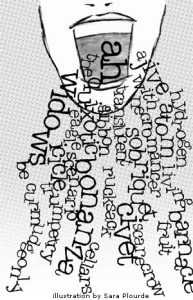Five days a week, Toronto poet Rob Read sits down at his computer between eight and 10 a.m. and scours through his spam. He is not interested in purchasing penis enlargement pills, Viagra discounts or saving the orphaned daughter of Mr. Boni Bawa of the Democratic Republic of Congo, Central Africa. Rather, he is engrossed by the lines of irrelevant, random words tagged at the end of the unsolicited e-mail.
Read pours over the fragmented gibberish in spam e-mails (formulated to masquerade the actual advertisement), sometimes identifying recognizable passages from books to being completely astounded by incomprehensible nonsense.
Whatever it is, something from a single piece of spam will catch the poet’s attention and for 15 to 30 minutes, Read strings together lines, adds, subtracts and changes words and verb tenses until he achieves the first draft of a poem. He then sends his finished work to people on his “daily treated spam” e-mail list. He has been doing this since September 2003.
Read’s creation is a small contribution to the language art called spam poetry, the passion, interest and hobby of a small community of people connected on the Internet.
“Typically, the spam poem becomes the anti-capitalist poem,” says Read who wrote O SPAM, POAMS: Selected Daily Treated Spam 2003 — 2005 published by Book Thug, “… Spam poetry tries to jam the signal and make it into art instead of what spam was originally intended for, which was to make money.”
Read says the approach to spam poetry is unique to each individual. Kristin Thomas, perhaps the most famous spam poet, who, after receiving attention from the BBC News, only used the subject headings of spam to create the poems featured on her outdated spampoetry.com blog.
“Some people will frame it as straight-up found poetry and have not declared themselves the author of that work whereas I am actively engaged in high-jacking the spam,” says Read of his approach that requires modifications to the original document.
“I see myself in the tradition of using garbage as art,” he says. “You don’t have to go to the art store and buy expensive materials to be an artist. Art can be a form of recycling, retooling, reusing.”
Lee Ranaldo of Sonic Youth has mixed feelings about spam. A published poet, Ranaldo released a book of spam poetry, Hello From The American Desert in late 2007 with Silver Wonder Press.
“I still hate it,” says Ranaldo of the copious amounts of spam he receives daily, “but at least there is something really interesting about it… It reminds me of surrealist automatic writing. I just keep collecting them to see where they go.” Ranaldo saves highlights from spam e-mails, entire passages or just subject titles, in word documents on his computer. “I have an insanely huge collection at this point,” he says.
Ranaldo’s approach to spam poetry is similar to Read’s process that includes heavy modification to the original e-mail although Ranaldo typically borrows words from various spam to achieve a single poem.
“It is a bit of exquisite corpse, when you draw one panel of a picture and fold it over and give it to the next person,” says Ranaldo of his process. “You start off with a line and try and figure out what will go next to it.”
Morton Hurley, the editor of The Anthology of Spam Poetry published by Vértice 1925, wonders if spam poets like Ranaldo and Read will ever be recognized and accepted by the academic community. Despite spam poetry’s connection to the highly regarded and studied experimental cut-up works of Bryon Gysin and William S. Burrough, spam is not considered a serious form of poetry.
“I submitted pieces to the Harvard Library of Poetry and it was promptly rejected,” says Hurley. “I’ve submitted to poetry and writers magazines and they absolutely reject the idea of spam poetry. Maybe for that very notion that it is too instantaneous, too easy and it doesn’t have that longevity.”
Hurley remains indifferent to the fact that academic circles see his passion as a passing novelty. “The higher academic community does not see it as a serious art form and perhaps it is not, but it should be taken into consideration as a modern use of language,” he says. “It wouldn’t exist without the internet which permeates everything in our lives. Why not consider something that is a byproduct of that?”
However, the future of spam poetry is uncertain as technology improves. As filters become stronger, effectively blocking junk mail that has become more concise, the impact will no doubt affect spam poetry.
“I believe that spam poetry will continue to exist as long as there are spam messages. What I am looking forward to is how the spam poetry form will change and evolve,” says Hurley. “I suspect that as e-mail systems become more sophisticated, spam messages will become more visually based with images and video… and so spam poetry will evolve into a visual poem form similar to Mail Art and No Wave Cinema. I find that very exciting.”

